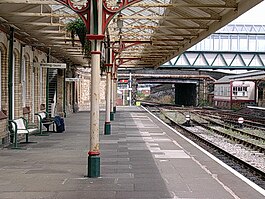Workington railway station
| Workington |
|
|---|---|
 |
|
| Location | |
| Place | Workington |
| Local authority | Allerdale |
| Coordinates | 54°38′42″N 3°33′29″W / 54.645°N 3.558°WCoordinates: 54°38′42″N 3°33′29″W / 54.645°N 3.558°W |
| Grid reference | NX995288 |
| Operations | |
| Station code | WKG |
| Managed by | Northern |
| Number of platforms | 2 |
| DfT category | E |
| Live arrivals/departures, station information and onward connections from National Rail Enquiries |
|
| Annual rail passenger usage* | |
| 2011/12 |
|
| 2012/13 |
|
| 2013/14 |
|
| 2014/15 |
|
| 2015/16 |
|
| National Rail – UK railway stations | |
| * Annual estimated passenger usage based on sales of tickets in stated financial year(s) which end or originate at Workington from Office of Rail and Road statistics. Methodology may vary year on year. | |
|
|
|
Workington railway station serves the town of Workington in Cumbria, England. The railway station is a stop on the scenic Cumbrian Coast Line 33 miles (53 km) south west of Carlisle. Some through trains to the Furness Line and from Sunderland stop here. It is operated by Northern who provide all passenger train services.
The first Workington station on the Cumbrian Coast Line was built in the area known as Priestgate Marsh for the Whitehaven Junction Railway. Although the WJR was opened from Maryport to Workington in 1845 the WJR was advertising for tenders for building the station at Workington in October 1846. The WJR station had a single arrival and departure platform (the line was single until 1860) and no platform canopy "the platform is open to the prevailing winds, and " (we) " believe Workington is the only first-class station in Great Britain so unprovided with shelter" complained the Workington town trustees in 1858. In 1854 mis-set points led to a Maryport-Whitehaven goods train being routed into the end bay used by the Workington - Cockermouth trains: the goods train demolished the buffers and "dashed through" the booking office, the porter's office, and the gentleman's waiting room, carrying away the street wall of the station building, and finally coming to rest at the far wall of the ladies' waiting room. The booking office clerk having seen the train approaching, ensured no lives were lost but "the station" reported the Cumberland Pacquet "is of course a perfect wreck" and had to be re-built. (Immediately after the accident, the gas supply to the station was turned off at the meter, but it was noted that three gas lights continued to burn - the town trustees (who owned the town gasworks) declined to restore the supply until the WJR gave a satisfactory explanation or adequate compensation).
The London & North Western Railway took over the Whitehaven Junction and Workington & Cockermouth lines in 1866, and replaced the WJR station. The LNWR station was extended further north than the WJR one, with its principal entrance now facing Station Road; a footpath through the goods yard was suppressed, and South Quay (linking the harbour with the town) was carried over the railway on a bridge, replacing a dangerous level crossing.
...
Wikipedia
